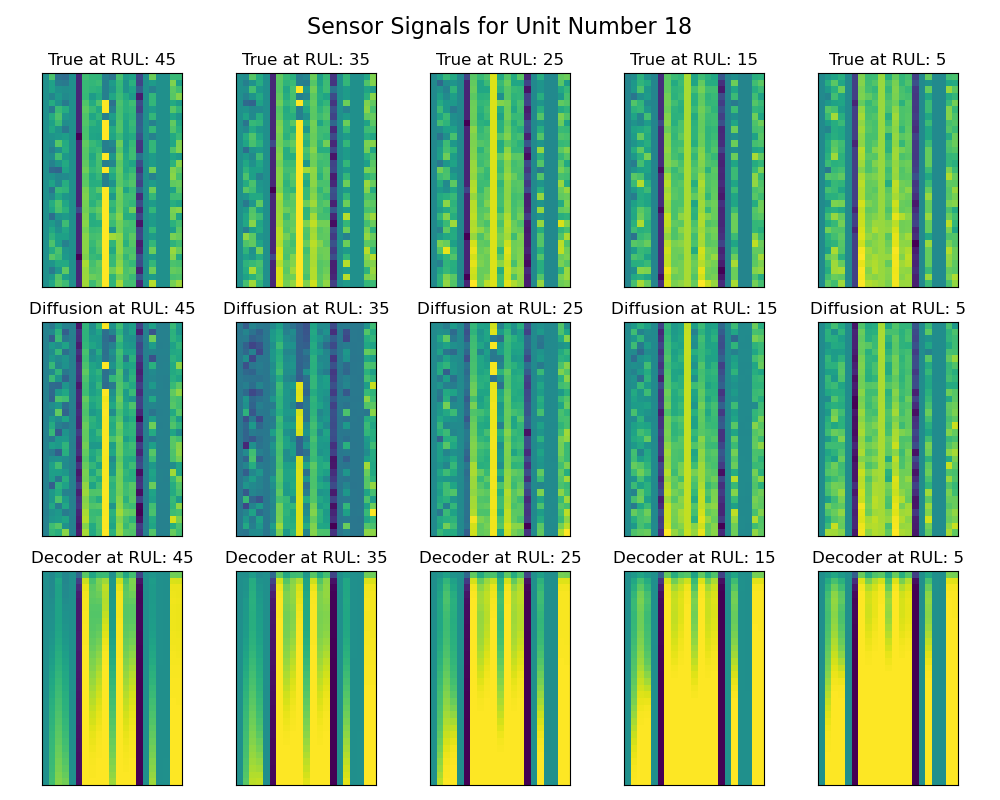This repository contains the code and data for my Master's thesis on Remaining Useful Life (RUL) prediction. The thesis focuses on the application of machine learning and deep learning techniques to predict the remaining useful life of equipment and generate synthetic data.
The main contributions of this work are as follows:
- The introduction of the Time-Series Hybrid Autoencoder (TSHAE): This novel autoencoder-based model is capable of estimating differentiable degradation trajectories in the latent space. By leveraging a complex loss function based on trajectory-based metric learning, regression, and reconstruction losses, the TSHAE constructs a low-dimensional and interpretable latent space.
- An unsupervised method for extrapolating degradation trajectories: The study proposes a technique to extend the initial test degradation trajectory. By employing extrapolation techniques based on the most similar degra- dation pattern and trajectory using latent spatial properties, the model gen- erates complete degradation trajectories.
- Utilizing extrapolated trajectories for generating input sensor signals: This is achieved through a generative diffusion model based on an adapted U-Net architecture. By conditioning the model on the latent trajectory representation, the generative model can generate realistic input sensor signals that align with the extrapolated degradation trajectories.
The code in this repository was developed using the following environment:
python==3.9.16
numpy==1.24.3
pandas==1.5.3
matplotlib==3.7.1
torch==2.0.1
scikit-learn==1.2.0
scipy==1.9.3
tqdm==4.65.0
tslearn==0.6.1
The CMAPSSData directory contains the necessary data for the RUL prediction task. It includes the training, testing, and RUL files for different equipment categories.
The CMAPSSData directory contains the dataset files required for the RUL prediction task. For more information about the dataset, refer to the readme.txt file in the CMAPSSData directory.
Here are short descriptions of the scripts used in this project:
- ddpm_models.py: Python script for conditional diffusion.
- tshae_models.py: Python script with Time Series Hybrid Autoencoder (TSHAE).
- tshae_train.py: Python script for Time Series Hybrid Autoencoder training.
- tshae_test.py: Python script for Time Series Hybrid Autoencoder test.
- ddpm_train.py: Python script for diffusion model training.
- ddpm_infer_validation.py: Python script for genrating sensor data for validation dataset.
- ddpm_infer_latent.py: Python script for genrating sensor data for latent space trajectories.
- noise_tester.py: Python script for testing TSHAE for noise resistance.
- loss.py: Python script for loss functions.
- metric.py: Python script for metrics calculations.
- metric_dataloader.py: Python script for C-MAPSS dataloader.
- multirun_results_getter.py: Python script for getting multi-run results.
The Configs directory contains YAML configuration files for different components of the project, such as data preprocessing, diffusion, model selection, loss functions, optimizers, schedulers, and more.
The project utilizes the Hydra library for handling and managing these configurations.
config.yaml: General project configuration file.data_preprocessor: Configuration files for data preprocessing related settings.diffusion: Configuration files for diffusion-related settings.knnmetric: Configuration files for latent space KNN metric.model: Configuration files for model selection and architecture settings.loss: Configuration files for different loss functions.noise_tester: Configuration files for testing TSHAE for noise resistance.optimizer: Configuration files for optimizer settings.scheduler: Configuration files for learning rate scheduler settings.random_seed: Configuration file for setting random seed.trainer: Configuration files for training TSHAE.
The Outputs directory is used to store the output files generated during the project, such as trained model weights, evaluation results, and plots.
The requirements.txt file contains the necessary Python packages and dependencies to run the code in this repository.
To use this code, follow these steps:
- Install the required dependencies by running:
pip install -r requirements.txt. - Update the necessary configurations in the
Configsdirectory to match your specific needs. - Run the desired scripts or notebooks for data preprocessing, model training, testing, and evaluation.
To run multiple train TSHAE experiments with Hydra sweeper:
foo@bar:~/MDS-Thesis-RULPrediction$ python tshae_train.py -m hydra.sweeper.max_batch_size=10To gather results of Hydra multirun experiment:
foo@bar:~/MDS-Thesis-RULPrediction$ python multirun_results_getter.py --multirun_path "./path_to_multirun_experiment/"To test TSHAE
foo@bar:~/MDS-Thesis-RULPrediction$ python tshae_test.py --checkpoint_path ./best_models/FD003/tshae/To infer generated sensor signals by DDPM model:
foo@bar:~/MDS-Thesis-RULPrediction$ python ddpm_infer_validation.py


